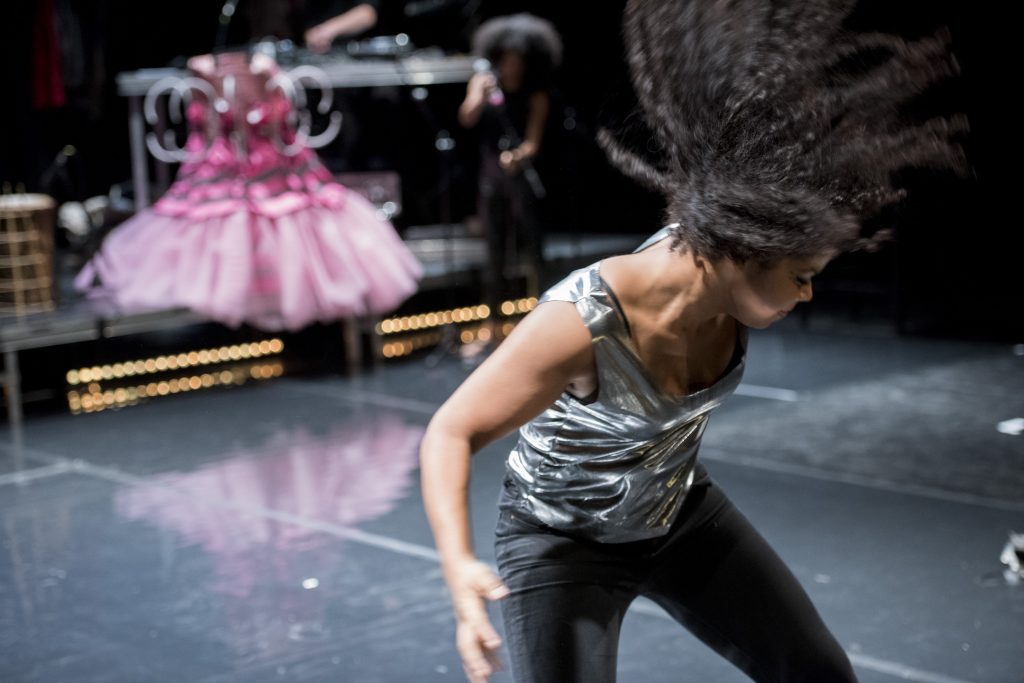
- News
Chombotrope: opening questions on power, ownership and the future
An interview with Stephanie Thiersch and Kefa Oiro about the fashionconcert Chombotrope.
Source: Berliner Festspiele.
The Jitta Collective is a collaboration of various artists, dancers and musicians led by the Kenyan dancer, choreographer and director Kefa Oiro and the German choreographer and media artist Stephanie Thiersch. In 2017, The Jitta Collective made the show Chombotrope, which has its Dutch premiere on 2 November at SPRING in Autumn.
Which journey is the audience invited to in your work Chombotrope?
Thiersch: A very diverse journey, a very colorful journey.
Oiro: It’s an open journey also, an open journey of rediscovery.
What does ‘chombotrope’ mean?
Oiro: It’s a made up word, an invention. ‘Chombo’ is the Swahili word for container/vessel. And ‘Trope’ is the visualization of a poetic expression. We mixed it together. ‘Chombotrope’ is for us the container in which we find ourselves and in which we make the journey together, from one geography to the next.
In what way do you consider fashion or clothes as an instrument of power?
Thiersch: Fashion is a style and it means also something. You can change your character with fashion. And in this piece we talk a lot about the use and misuse of power, and fashion is an instrument for that. It can be fake power, it can be fake weakness, it can be real power or real weakness. Fashion is a way of juggling with these notions. And it’s also a way of expressing yourself, of course. And in the end it is a way of freedom, freedom of expression and fantasy. Which I think is an important part of our work.
Oiro: It’s a definition of ownership as well. There are grouping, classes, and the identity behind it. Especially in Kenya we have conflicts of where the ownership lies and where the class divides. So there is a strong sense of ownership around it.
What is your artistic strategy to question and deconstruct it?
Thiersch: I think the fact that we work all together, and the most interesting part of the journey is that we were in different countries for the curation of the collective. But also we passed most of the time not in rehearsal space creating, but discussing the issues. Which doesn’t mean that our approach is basically political but of course it’s a deconstruction of each issue we have because we shed light on very different perspectives of the same problem or issue. So, it’s a deconstruction, it’s getting fragmented. It opens questions and doesn’t give necessarily answers.
How did you find together as a collective?
Oiro: The route to Chombotrope began when Stephanie and I were looking at the issues of clothing. It’s transformation from Europe, going all the way to Africa as a secondhand clothing and becomes an economy there. We started to explore this route and it was called mitumba, where we created a fashion setting and talked about al these questions. That gave an impulse to discuss something further around this. From there we started a research around it. Stephanie proposed different people to include. Then we had a research where we travelled to Kenya and Uganda and met interesting people. The fashion designer we work with we met in Uganda and other interesting people like musicians and DJ’s in Nairobi. Through this research of moving to this place to the next, we met interesting people and that’s how we shared collectively our materials.
Do you consider Chombotrope an Afrofuturistic piece?
Thiersch: We talked about Afrofuturism a lot but I think its something by its own and we are not creators of Afrofuturism I would say. But it’s something that is close to us and we discussed it a lot. And we definitively don’t look backwards, we look into the future. We talk about ownership and new identities and that goes towards the future definitively. So, there is something about that in it, but I wouldn’t call us Afrofuturists. The definition is also coming more from the States, right?
Oiro: Yes. But I also want to shy away from the label ‘afro’, we don’t stick ourselves to that kind of labeling. And just like Stephanie says, we do not look back but to the future. Its being open and being free to just dream and fantasize and all that. So, we let the audience that sees the performance decide from themselves, but we tend not to stick to that label.
Chombotrope takes place on Saturday November 2nd at SPRING in Autumn.